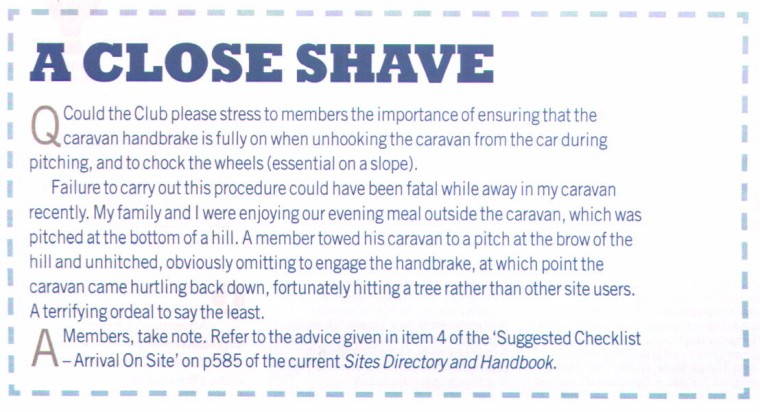
Safety on caravan sites - an example from the Caravan Club magazine, November 2006
For many years, the Caravan Club and many of its members have resisted calls for compulsory MoT-style testing of caravans. There are two central arguments - serious caravan accidents are few and far between (simply because there are not many caravans on the road) and many older caravans especially are a menace on the roads because of their appalling mechanical condition. Examples without a working handbrake are seen regularly at folk festivals.
However, the most important safety problem remains owners and drivers who know little or nothing about towing or potential hazards. This mirrors the position with ordinary cars - MoT tests in the UK are absurdly stringent on some minor aspects of safety (especially small areas of corrosion). This remains in effect a 'cash cow' for garages who can charge hundreds of pounds for poor quality welding that adds little or nothing to vehicle strength. The variation in standards applied in MoT tests is little short of a scandal - an issue to be covered elsewhere when I have time. Yet successive governments have failed to begin to deal with idiotic drivers who are a primary cause of serious accidents.
Caravan dealers charge £50 to £100 per hour for routine work - and no doubt they look forward to the days of compulsory testing in the UK, as has been the position in some European countries for many years. One consequence would be a large reduction of old caravans at folk festivals - and maybe some reduction in the total number of attendees.
Whilst the mechanical condition of vehicles and caravans is therefore a minor cause of accidents either on the road or on caravan sites, some folk festival sites (especially Sidmouth) were for many years an especial risk because old caravans in poor condition and with inept people in charge were parked above rows of tents. It was an accident waiting to happen.

The photos shown below are all from 2006.
The rusty underside of a G reg (c. 1990) Ford Fiesta that had been subjected to some typical 'garage welding'. The car should have been scrapped instead! The strength of crumple zones in modern cars is illustrated in the other two photographs - a full frontal impact of an MR2 with a tree or lamp-post (amazingly the headlights are still in perfect condition) and a Corsa that is a little shorter than when it left the factory.
| The front
underside of a 1990 Ford Fiesta close to subframe and suspension mounting points. It had
been copiously (and badly) welded - most of the 'repairs' could be prised off with a large
screwdriver. Typically of 'garage welding', the work added little to the strength of the car. It had apparently been on the road until shortly before it was scrapped. |
|
| The underside of
an old Ford Fiesta close to the rear suspension mounting points (top right of picture). The car should have been scrapped years before it got to this state - some MoT garages are lax about corrosion (especially if they can make a lot of money out of repairing it badly) yet others fail cars for the most trivial and inconsequential bits of corrosion. "Old Fords never die - they just rust away." |
|
| Full frontal impact in a modern sports car - the headlights survived - as probably did the passengers. | |
| Rear of the Year? An old Vauxhall Corsa after it had been badly shunted. The front was quite a mess too.... |